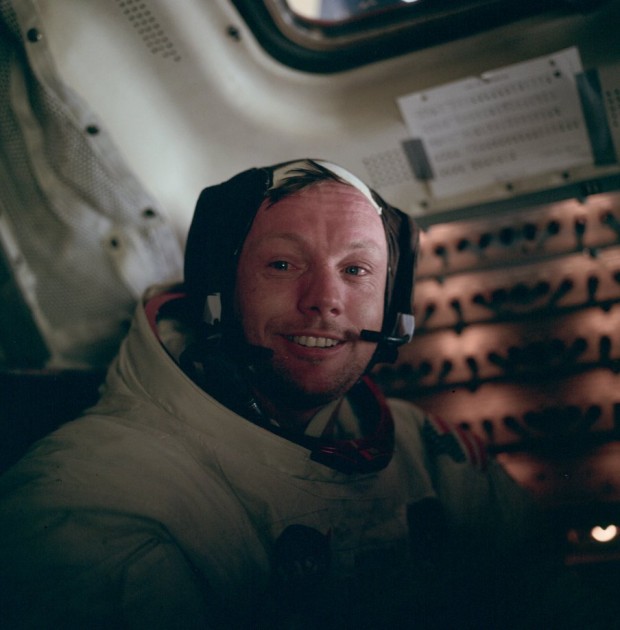An iconographic and text archive related to communication, technology and art.
☛ NASA – Johnson Space Center History Portal: Portrait of Neil Armstrong shot by Buzz Aldrin in Lunar Module after historic moonwalk, July 20, 1969. Photo AS11-37-5528. Public domain. See higher resolution.
Neil Armstrong’s first words has he stepped on the Moon are well known, but the “salmon swim upstream” answer he gave to a group of journalists prior to the mission is also worth remembering. Here’s how Norman Mailer describes the event in Part II of his famous serialized essay A Fire on the Moon, first published in Life magazine:
Why, why ultimately, they were asking, is it so important to go to the moon? Man to man, they were asking, brain to brain, their leverage derived from the additional position of asking a writer to small-town boy: why is it important?
Armstrong tried to be general. He made a speech in fair computerese about the nation’s resources, and the fact that NASA’s efforts were now tapped into this root. Well, then, asked a dry voice, are we going to the moon only for economic reasons, only to get out of an expensive hole? No, said Armstrong.
Do you see any philosophical reason why we might be going? the voice went on, as if to imply: are you aware there is philosophy to existence as well?
Armstrong had now been maneuvered to the point where there was no alternative to offer but a credo, or claim that he was spiritually neuter. That would have violated too much in him. Yes, he blured now, as if, damn them and damn their skills, they had wanted everything else of him, including his full cooperation, now damn them good,they could have his philosophy too if they could comprehend it. “I think we’re going,” he said, and pause, static burning in the yaws of his pause, “I think we’re going to the moon because it’s in the nature of the human being to face challenges.” He looked a little defiant, as if probably they might not know, some critical number of them might never know what he was talking about, “It’s by the nature of his deep inner soul.” The last three words came out as if they had seared his throat by their extortion. How his privacy had been invaded this day. “Yes,” he nodded, as if noting what he had had to give to writers, “we’re required to do these things just as salmon swim upstream. (“The Psychology of Astronauts” by Norman Mailer, Part II of A Fire on the Moon, Life magazine, November 14, 1969, p. 59)
The above portrait shot by Buzz Aldrin is frame no. 5528 from magazine 37/R which belongs to the Apollo 11 Image Library (thus the call number AS11-37-5528). It was shot with an 70-mm Hasselblad Electric Camera equipped with a 80mm lens (see Appendix A: Summary of Apollo 11 Photographic Coverage). From the Appolo Lunar Surface Journal archive, we have this description:
Buzz took this picture of Neil in the cabin after the completion of the EVA. Neil has his helmet off but has not yet doffed his “Snoopy” cap. The circuit breaker panels are illuminated, and a small floodlight is on at the lower right. A circuit breaker chart has been fixed up on the wall with gray tape, below the rendezvous window in the cabin roof.
From The Associated Press (via The New York Times):
Neil Armstrong was a quiet self-described nerdy engineer who became a global hero when as a steely-nerved pilot he made “one giant leap for mankind” with a small step on to the moon. The modest man who had people on Earth entranced and awed from almost a quarter million miles away has died. He was 82. […]
Armstrong commanded the Apollo 11 spacecraft that landed on the moon July 20, 1969, capping the most daring of the 20th century’s scientific expeditions. His first words after setting foot on the surface are etched in history books and the memories of those who heard them in a live broadcast.
“That’s one small step for (a) man, one giant leap for mankind,” Armstrong said. (“Neil Armstrong, First Man on Moon, Dies at 82”, August 25, 2012)
- By Philippe Theophanidis
- on
- ― Published in Technology
- Tagged: astronaut, Moon, NASA, Neil Armstrong, Norman Mailer, obituary, space

